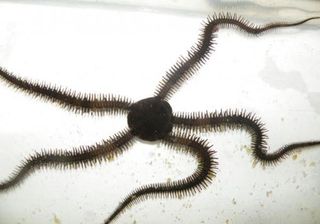Brittle Stars Move Like Humans

Starfishlike brittle stars have five thin arms and no central brain, but even so, they move in a carefully coordinated fashion similar to four-limbed animals (including humans). A new analysis delves into the details of brittle star locomotion.
Symmetry is at the heart of the mystery of brittle star movement.
Humans, and many other animals, from insects to birds, have bodies divided into two matching halves, a right and a left. Scientists describe this as bilateral symmetry.
Other animals, including jellyfish and sea anemones, have bodies that can be divided into matching halves in multiple ways. This is called radial symmetry. Brittle stars fit into this category; their bodies can be divided into matching halves five different ways. [Image Gallery: Quirky Sea Life]
Symmetry influences how an animal moves about. Animals with bilateral symmetry, like humans, have bodies specialized to move in one direction — forward. Many animals with radial symmetry don't move or do so slowly. When they do travel, most of these animals do so in a direction determined by their body's central axis, defined by the location of their mouths. Think of a jellyfish moving up and down in the water column.
This is why brittle stars are strange. Despite their five-way symmetry, the stars don't move according to their central axis. Instead, they move perpendicular to it using their five multijointed limbs to propel them along the seafloor.
To confirm that brittle stars are indeed using a coordinated gait similar to that of four-limbed animals, Henry Astley, a graduate student in evolutionary biology at Brown University, observed 13 blunt-spined brittle stars collected from the waters of Belize. Astley filmed the brittle stars crawling in an inflatable pool and digitized their movements to better analyze them.
Sign up for the Live Science daily newsletter now
Get the world’s most fascinating discoveries delivered straight to your inbox.
He found that, about 75 percent of the time, brittle stars oriented their movement around a central limb, which pointed the way for the rest of the body. The left and right forelimbs made large, coordinated movements. To turn, the brittle star simply picked a new lead limb.
When not "rowing" forward, the brittle stars reversed, with a central limb trailing and the other four making large movements.
While these patterns of movement resemble that of a bilaterally symmetrical animal, the brittle stars do not alternate limbs as many four-limbed animals do. (When walking, for example, you alternate between your left and right foot; the brittle stars moved both of their forelimbs at the same time.)
The study is detailed in the Journal of Experimental Biology.
You can follow LiveScience senior writer Wynne Parry on Twitter @Wynne_Parry. Follow LiveScience for the latest in science news and discoveries on Twitter @livescience and on Facebook.
